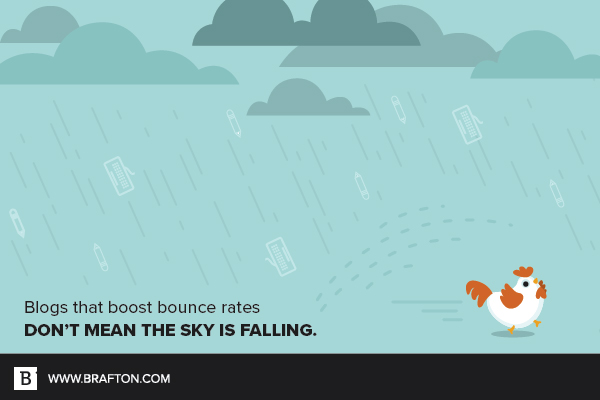Bounce rates get a lot of buzz.
With every business hoping to capitalize on its online presence and turn website visitors into paying customers, it’s only natural to focus on key indicators as the Holy Grail to success.
However, there’s no point obsessing over blog metrics if you don’t understand how they work and what they mean.

The anatomy of a bounce
A bounce rate is the percentage of visitors who leave your website after checking out a single page. Any time someone lands on a blog post you’ve written leaves the site without navigating to another portion of your website, that counts as a bounce.
Now, incredibly high bounce rates across your site’s core landing pages should be cause for concern, according to Jeff Baker, Director of Digital Marketing Strategy at Brafton.
“If 90 percent of people are landing on your site’s core landing pages and then leaving without checking out other pages or taking actions, something is probably wrong,” he said. “Maybe the page is loading super slow, or has terrible UX, or the content doesn’t match the searcher’s intent, or there are no navigation options.”
However, it’s also important to put bounce rates in perspective, especially in terms of blog content.
“Blog consumption, by nature, is extremely top of funnel, dancing on the rim of the top of the funnel,” Jeff continued. “It’s the awareness stage. It’s not the same intent of someone landing on a product or solutions page. Someone who does that is shopping, someone who clicks on a blog is learning something. Maybe they want to know how to do something, find a how-to article, use it, then leave.”
While the content you provide should be valuable and relevant in hopes of sticking in a user’s mind and enticing them to return to your site, you should also count on the fact that any given website will have a bounce rate of between 70 and 80 percent regardless of content quality.
Is your website’s #bouncerate worth bragging about or crying about? Here’s how to tell: https://t.co/GAMyVwA1Us pic.twitter.com/Qk3snGzqLH
— RocketFuel (@gorocketfuel) February 3, 2017
The more blog posts you create, the higher your website’s average bounce rate will be. And that’s OK.
“You’re generating search presence,” Jeff said. “The reason we create blog content is to expand a digital footprint. Content marketing helps web properties pop up in a variety of search queries that they wouldn’t otherwise show up for with a static website. That’s the whole point: Get more eyeballs on your very specific website and content. More blog posts mean more varieties of search query groups that will generate your site in SERP results. It also means more bounces.”
In an ideal world, each blog post would lead visitors to other pages. While you can encourage such behavior through targeted calls to action and strategic UX, you must understand your audience and its needs. Individuals at the top of the sales funnel are far more likely to be scared off by heavy-handed tactics, meaning you can do more harm than good by trying to force blog readers to dive deeper into your website.
Use an adjusted bounce rate solution
It’s clear blog posts can skew your metrics in terms of bounce rate. However, bounce rates themselves can distort other key performance indicators.
Google Analytics’ tracking code time stamps every page a website visitor requests. It determines how long these individuals are on site based on the next page requested. However, if they fail to request a second page, the visit will be registered as zero time on site. Because of this, blog posts can also drag down the entire site’s average time on site.
“A bounce is going to happen every time someone sees one page and leaves your site,” Jeff said. “However, if someone goes to one of your blogs and spends a predetermined amount of time on it, you may not want to treat it as a bounce. You can customize your analytics to not count those as bounces.”
By creating a time threshold event for how long a visitor stays on a blog page, you can gain more accurate insight into how people are consuming your blog content. After all, not all bounces are created equal.
“You need to view all metrics through the lens of business transactions.”
Eyes on the prize
Once you understand how a blog will impact your metrics, it’s easier to avoid unnecessary panic and stay focused on what really matters: Conversions.
“[Bounce rates are] just a number,” Jeff said. “Your goal is to make money. If you determine that a landing page makes people stay on the site longer and convert more often, then that’s a good landing page and you need to compare it to the ones that don’t. However, if people are converting with low time on site and high bounce rates, you don’t necessarily need to change anything. You need to view all metrics through the lens of business transactions. A low bounce rate is not a goal, but making money is. If a high bounce rate is indicating that a page is failing to perform commercially, then you have an insight.”
In short, great bounce rates and high time on site don’t mean much if they’re not also providing return on investment.





